Understanding the World of Tourism: Positive and Negative Impacts on Economy, Environment, and Socio-Cultural Aspects
VerifiedAdded on 2023/06/08
|7
|2150
|426
AI Summary
This essay discusses the development of contemporary tourism and its positive and negative impacts on the economy, environment, and socio-cultural aspects. It explores the factors affecting the tourism industry and its contribution to GDP. The impact of COVID-19 on the industry and the measures taken for sustainable development are also discussed.
Contribute Materials
Your contribution can guide someone’s learning journey. Share your
documents today.
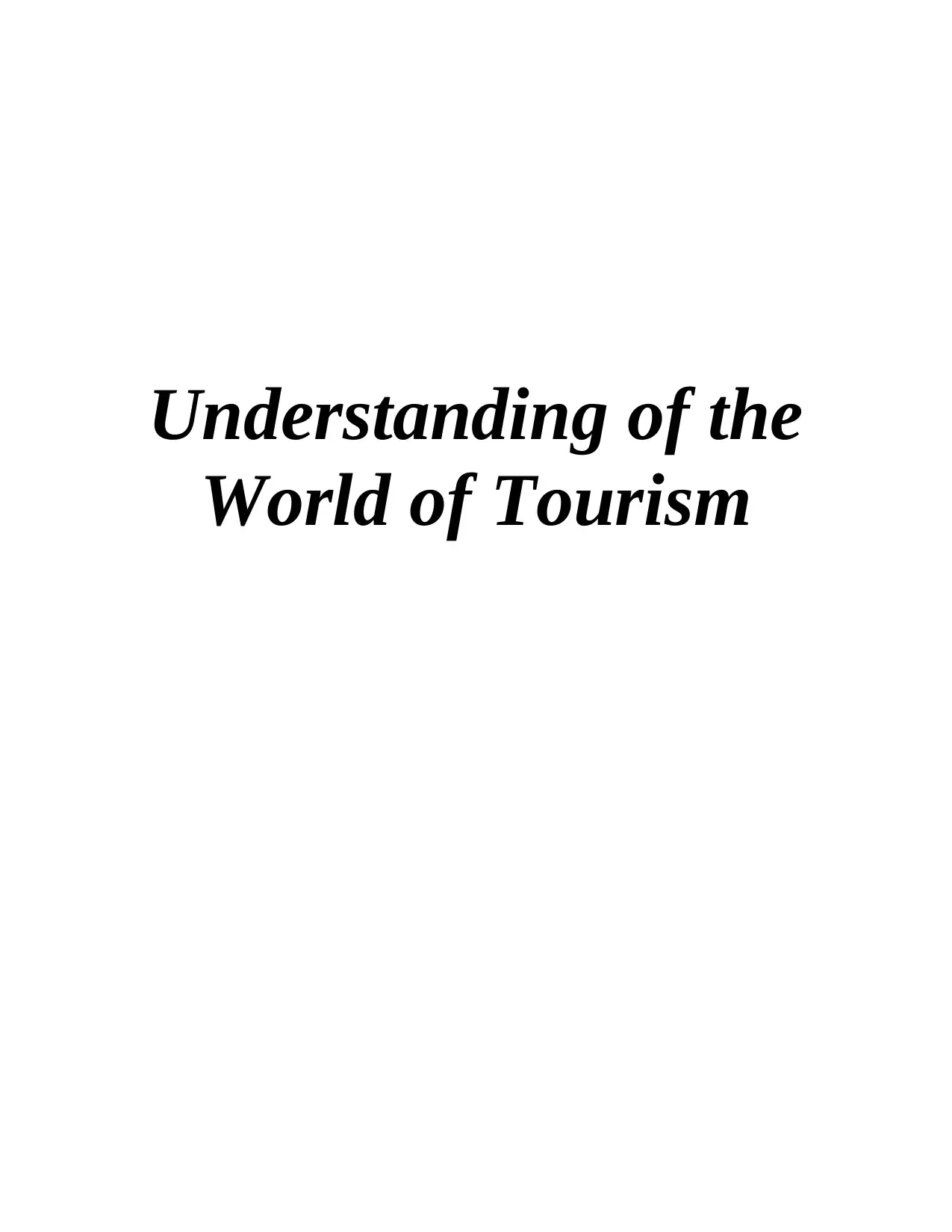
Understanding of the
World of Tourism
World of Tourism
Secure Best Marks with AI Grader
Need help grading? Try our AI Grader for instant feedback on your assignments.

Table of Contents
INTRODUCTION...........................................................................................................................3
MAIN BODY...................................................................................................................................3
Describe the development of contemporary tourism and discuss its positive and negative
economic, environmental and socio-cultural impacts.................................................................3
CONCLUSION................................................................................................................................5
REFERENCES................................................................................................................................7
INTRODUCTION...........................................................................................................................3
MAIN BODY...................................................................................................................................3
Describe the development of contemporary tourism and discuss its positive and negative
economic, environmental and socio-cultural impacts.................................................................3
CONCLUSION................................................................................................................................5
REFERENCES................................................................................................................................7
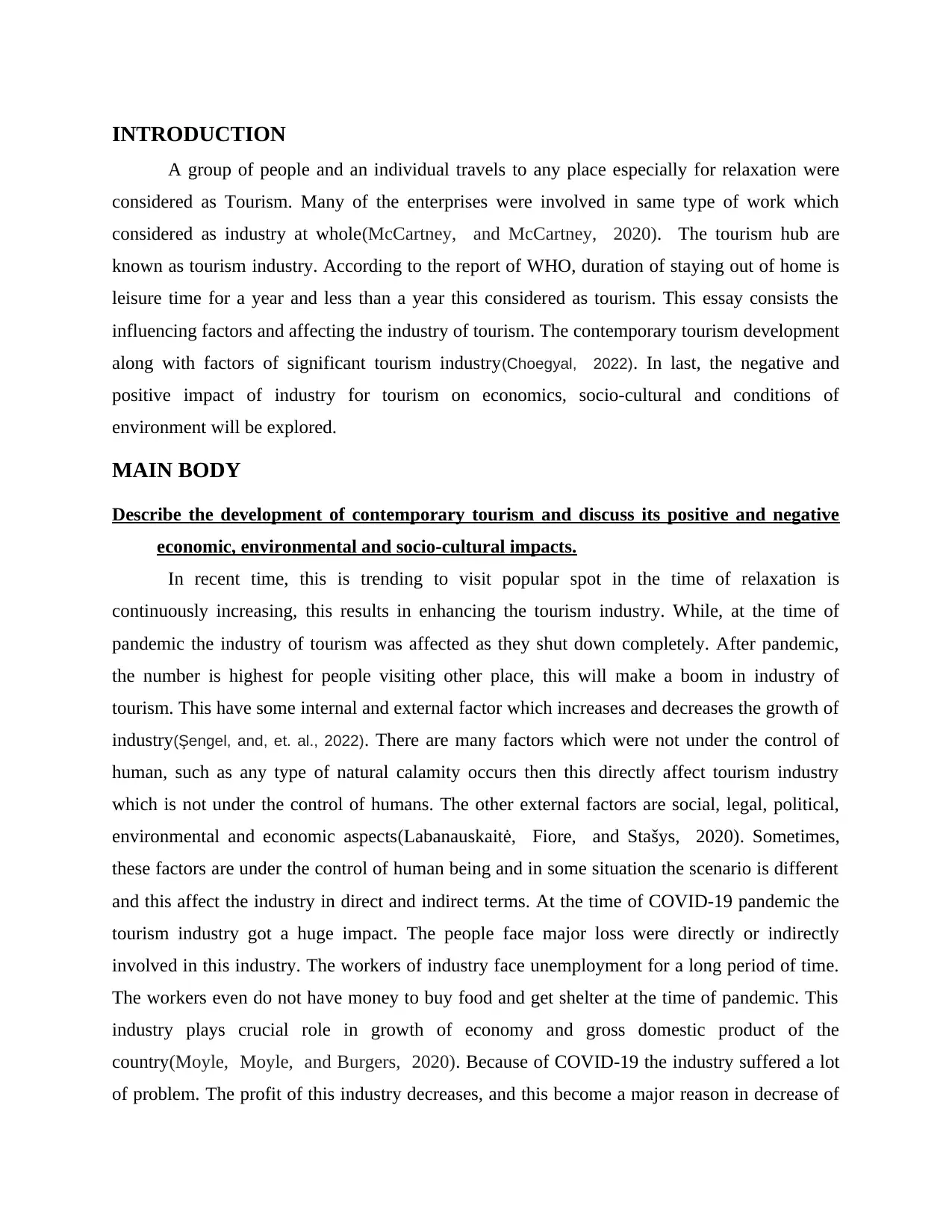
INTRODUCTION
A group of people and an individual travels to any place especially for relaxation were
considered as Tourism. Many of the enterprises were involved in same type of work which
considered as industry at whole(McCartney, and McCartney, 2020). The tourism hub are
known as tourism industry. According to the report of WHO, duration of staying out of home is
leisure time for a year and less than a year this considered as tourism. This essay consists the
influencing factors and affecting the industry of tourism. The contemporary tourism development
along with factors of significant tourism industry(Choegyal, 2022). In last, the negative and
positive impact of industry for tourism on economics, socio-cultural and conditions of
environment will be explored.
MAIN BODY
Describe the development of contemporary tourism and discuss its positive and negative
economic, environmental and socio-cultural impacts.
In recent time, this is trending to visit popular spot in the time of relaxation is
continuously increasing, this results in enhancing the tourism industry. While, at the time of
pandemic the industry of tourism was affected as they shut down completely. After pandemic,
the number is highest for people visiting other place, this will make a boom in industry of
tourism. This have some internal and external factor which increases and decreases the growth of
industry(Şengel, and, et. al., 2022). There are many factors which were not under the control of
human, such as any type of natural calamity occurs then this directly affect tourism industry
which is not under the control of humans. The other external factors are social, legal, political,
environmental and economic aspects(Labanauskaitė, Fiore, and Stašys, 2020). Sometimes,
these factors are under the control of human being and in some situation the scenario is different
and this affect the industry in direct and indirect terms. At the time of COVID-19 pandemic the
tourism industry got a huge impact. The people face major loss were directly or indirectly
involved in this industry. The workers of industry face unemployment for a long period of time.
The workers even do not have money to buy food and get shelter at the time of pandemic. This
industry plays crucial role in growth of economy and gross domestic product of the
country(Moyle, Moyle, and Burgers, 2020). Because of COVID-19 the industry suffered a lot
of problem. The profit of this industry decreases, and this become a major reason in decrease of
A group of people and an individual travels to any place especially for relaxation were
considered as Tourism. Many of the enterprises were involved in same type of work which
considered as industry at whole(McCartney, and McCartney, 2020). The tourism hub are
known as tourism industry. According to the report of WHO, duration of staying out of home is
leisure time for a year and less than a year this considered as tourism. This essay consists the
influencing factors and affecting the industry of tourism. The contemporary tourism development
along with factors of significant tourism industry(Choegyal, 2022). In last, the negative and
positive impact of industry for tourism on economics, socio-cultural and conditions of
environment will be explored.
MAIN BODY
Describe the development of contemporary tourism and discuss its positive and negative
economic, environmental and socio-cultural impacts.
In recent time, this is trending to visit popular spot in the time of relaxation is
continuously increasing, this results in enhancing the tourism industry. While, at the time of
pandemic the industry of tourism was affected as they shut down completely. After pandemic,
the number is highest for people visiting other place, this will make a boom in industry of
tourism. This have some internal and external factor which increases and decreases the growth of
industry(Şengel, and, et. al., 2022). There are many factors which were not under the control of
human, such as any type of natural calamity occurs then this directly affect tourism industry
which is not under the control of humans. The other external factors are social, legal, political,
environmental and economic aspects(Labanauskaitė, Fiore, and Stašys, 2020). Sometimes,
these factors are under the control of human being and in some situation the scenario is different
and this affect the industry in direct and indirect terms. At the time of COVID-19 pandemic the
tourism industry got a huge impact. The people face major loss were directly or indirectly
involved in this industry. The workers of industry face unemployment for a long period of time.
The workers even do not have money to buy food and get shelter at the time of pandemic. This
industry plays crucial role in growth of economy and gross domestic product of the
country(Moyle, Moyle, and Burgers, 2020). Because of COVID-19 the industry suffered a lot
of problem. The profit of this industry decreases, and this become a major reason in decrease of

GDP of the country. As compared from 2019 the domestic visitor count will fall by 48% and
international visitors count fall by 68.9%. At this time, around 62 million people lost their
because of pandemic. This is the reason how pandemic of COVID-19 affect the industry of
tourism(Sattarova, 2022).
The economic factors are the factors in which country's financial or economic condition
will be determined. The industry of tourism contributes 10% indirectly and 3.5% directly in the
GDP of world. The tourism makes an impact on economic condition of the country and this is
further divided in three categories- first, the expenditure which is made by tourism, second is the
expenses done through the enterprise and in last the capital which is invested. The direct
contribution in an economy will be done when a tourist buy any goods or services such as
beverages and food, entertainment facilities and hotels, and many of the things which were
purchased by tourists(Ouyang, Liu, and Gui, 2021). At this point of time. Demand of these
products increases which will encourage people to start their own business. The indirect
contribution is done when the tax is charged through government at the time of buying any
product and other taxes like toll tax or taxes on the tickets while travelling to other country were
charged by government. There are two most essential impact for tourism industry or factors of
economy is which creates a lot of opportunities for employment(Núñez-Lara, and, et. al, 2022).
The local people get the opportunity for job, this industry needs a lot of people. At the time of
increasing opportunities for job in context of local people this also increase the income of local
people and this helps in enhance the living standard of local people(Weaver, 2022). Rise in
income of local people will implies direct contribution in country's economy. The most essential
thing is that the authority will take care for historical monuments and place, this will generate
income for improvement of them. This not only covers historical monuments but also cover
biodiversity and centuries for conservation. The government makes efforts to keep these place
safe and builds the proper infrastructure for them. The government made contribution in this and
people save these heritage things attracts more number of tourists and this generates more
income through practising the activities(Ozdemir, Ar, and Erol, 2020). In this, the negative
impact of industry on economy is that the tourists makes a lot of pollution and over consume the
natural resources. In this the negative point is that outsiders will come and start a seasonal
business which makes impact in two ways first the opportunity of employment for local people
international visitors count fall by 68.9%. At this time, around 62 million people lost their
because of pandemic. This is the reason how pandemic of COVID-19 affect the industry of
tourism(Sattarova, 2022).
The economic factors are the factors in which country's financial or economic condition
will be determined. The industry of tourism contributes 10% indirectly and 3.5% directly in the
GDP of world. The tourism makes an impact on economic condition of the country and this is
further divided in three categories- first, the expenditure which is made by tourism, second is the
expenses done through the enterprise and in last the capital which is invested. The direct
contribution in an economy will be done when a tourist buy any goods or services such as
beverages and food, entertainment facilities and hotels, and many of the things which were
purchased by tourists(Ouyang, Liu, and Gui, 2021). At this point of time. Demand of these
products increases which will encourage people to start their own business. The indirect
contribution is done when the tax is charged through government at the time of buying any
product and other taxes like toll tax or taxes on the tickets while travelling to other country were
charged by government. There are two most essential impact for tourism industry or factors of
economy is which creates a lot of opportunities for employment(Núñez-Lara, and, et. al, 2022).
The local people get the opportunity for job, this industry needs a lot of people. At the time of
increasing opportunities for job in context of local people this also increase the income of local
people and this helps in enhance the living standard of local people(Weaver, 2022). Rise in
income of local people will implies direct contribution in country's economy. The most essential
thing is that the authority will take care for historical monuments and place, this will generate
income for improvement of them. This not only covers historical monuments but also cover
biodiversity and centuries for conservation. The government makes efforts to keep these place
safe and builds the proper infrastructure for them. The government made contribution in this and
people save these heritage things attracts more number of tourists and this generates more
income through practising the activities(Ozdemir, Ar, and Erol, 2020). In this, the negative
impact of industry on economy is that the tourists makes a lot of pollution and over consume the
natural resources. In this the negative point is that outsiders will come and start a seasonal
business which makes impact in two ways first the opportunity of employment for local people
Secure Best Marks with AI Grader
Need help grading? Try our AI Grader for instant feedback on your assignments.
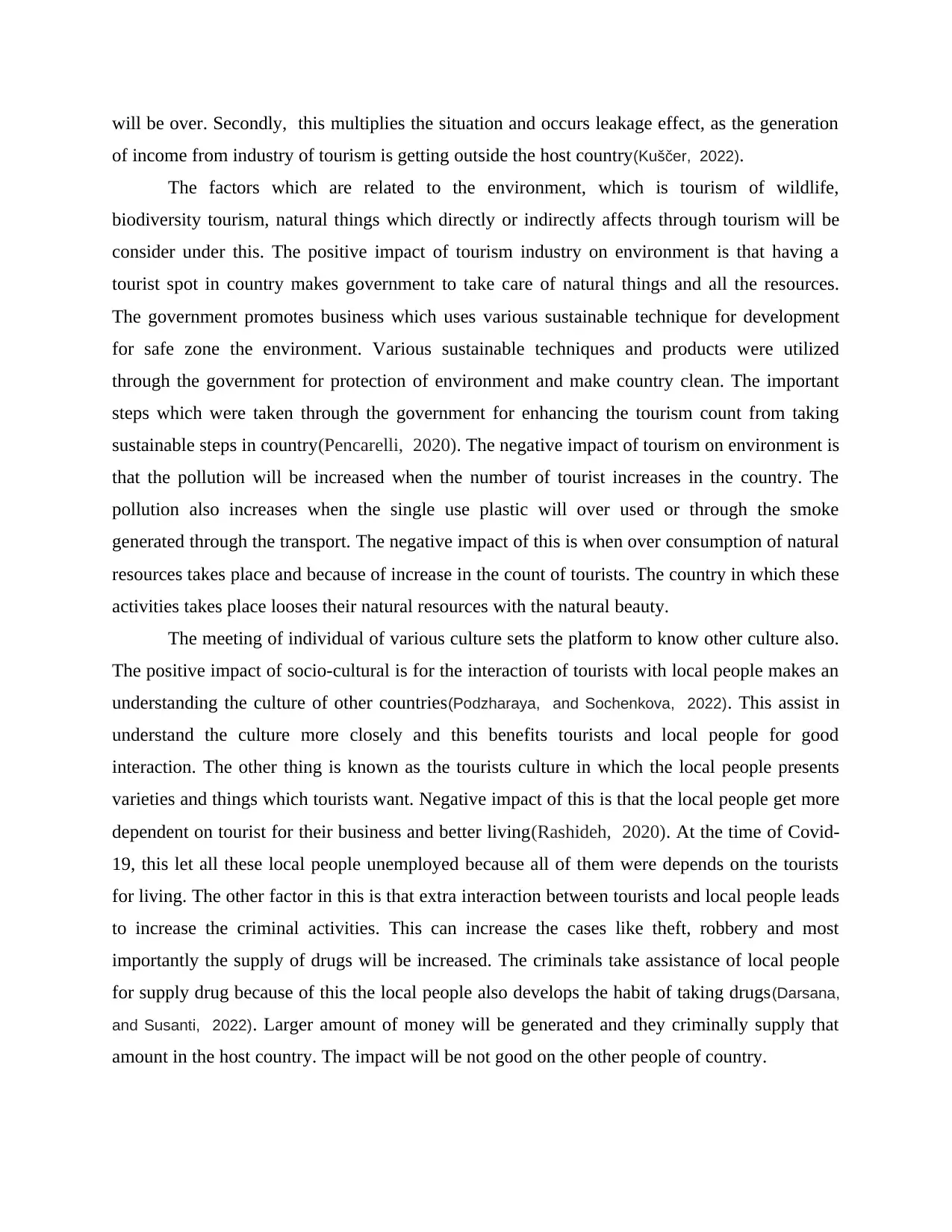
will be over. Secondly, this multiplies the situation and occurs leakage effect, as the generation
of income from industry of tourism is getting outside the host country(Kuščer, 2022).
The factors which are related to the environment, which is tourism of wildlife,
biodiversity tourism, natural things which directly or indirectly affects through tourism will be
consider under this. The positive impact of tourism industry on environment is that having a
tourist spot in country makes government to take care of natural things and all the resources.
The government promotes business which uses various sustainable technique for development
for safe zone the environment. Various sustainable techniques and products were utilized
through the government for protection of environment and make country clean. The important
steps which were taken through the government for enhancing the tourism count from taking
sustainable steps in country(Pencarelli, 2020). The negative impact of tourism on environment is
that the pollution will be increased when the number of tourist increases in the country. The
pollution also increases when the single use plastic will over used or through the smoke
generated through the transport. The negative impact of this is when over consumption of natural
resources takes place and because of increase in the count of tourists. The country in which these
activities takes place looses their natural resources with the natural beauty.
The meeting of individual of various culture sets the platform to know other culture also.
The positive impact of socio-cultural is for the interaction of tourists with local people makes an
understanding the culture of other countries(Podzharaya, and Sochenkova, 2022). This assist in
understand the culture more closely and this benefits tourists and local people for good
interaction. The other thing is known as the tourists culture in which the local people presents
varieties and things which tourists want. Negative impact of this is that the local people get more
dependent on tourist for their business and better living(Rashideh, 2020). At the time of Covid-
19, this let all these local people unemployed because all of them were depends on the tourists
for living. The other factor in this is that extra interaction between tourists and local people leads
to increase the criminal activities. This can increase the cases like theft, robbery and most
importantly the supply of drugs will be increased. The criminals take assistance of local people
for supply drug because of this the local people also develops the habit of taking drugs(Darsana,
and Susanti, 2022). Larger amount of money will be generated and they criminally supply that
amount in the host country. The impact will be not good on the other people of country.
of income from industry of tourism is getting outside the host country(Kuščer, 2022).
The factors which are related to the environment, which is tourism of wildlife,
biodiversity tourism, natural things which directly or indirectly affects through tourism will be
consider under this. The positive impact of tourism industry on environment is that having a
tourist spot in country makes government to take care of natural things and all the resources.
The government promotes business which uses various sustainable technique for development
for safe zone the environment. Various sustainable techniques and products were utilized
through the government for protection of environment and make country clean. The important
steps which were taken through the government for enhancing the tourism count from taking
sustainable steps in country(Pencarelli, 2020). The negative impact of tourism on environment is
that the pollution will be increased when the number of tourist increases in the country. The
pollution also increases when the single use plastic will over used or through the smoke
generated through the transport. The negative impact of this is when over consumption of natural
resources takes place and because of increase in the count of tourists. The country in which these
activities takes place looses their natural resources with the natural beauty.
The meeting of individual of various culture sets the platform to know other culture also.
The positive impact of socio-cultural is for the interaction of tourists with local people makes an
understanding the culture of other countries(Podzharaya, and Sochenkova, 2022). This assist in
understand the culture more closely and this benefits tourists and local people for good
interaction. The other thing is known as the tourists culture in which the local people presents
varieties and things which tourists want. Negative impact of this is that the local people get more
dependent on tourist for their business and better living(Rashideh, 2020). At the time of Covid-
19, this let all these local people unemployed because all of them were depends on the tourists
for living. The other factor in this is that extra interaction between tourists and local people leads
to increase the criminal activities. This can increase the cases like theft, robbery and most
importantly the supply of drugs will be increased. The criminals take assistance of local people
for supply drug because of this the local people also develops the habit of taking drugs(Darsana,
and Susanti, 2022). Larger amount of money will be generated and they criminally supply that
amount in the host country. The impact will be not good on the other people of country.
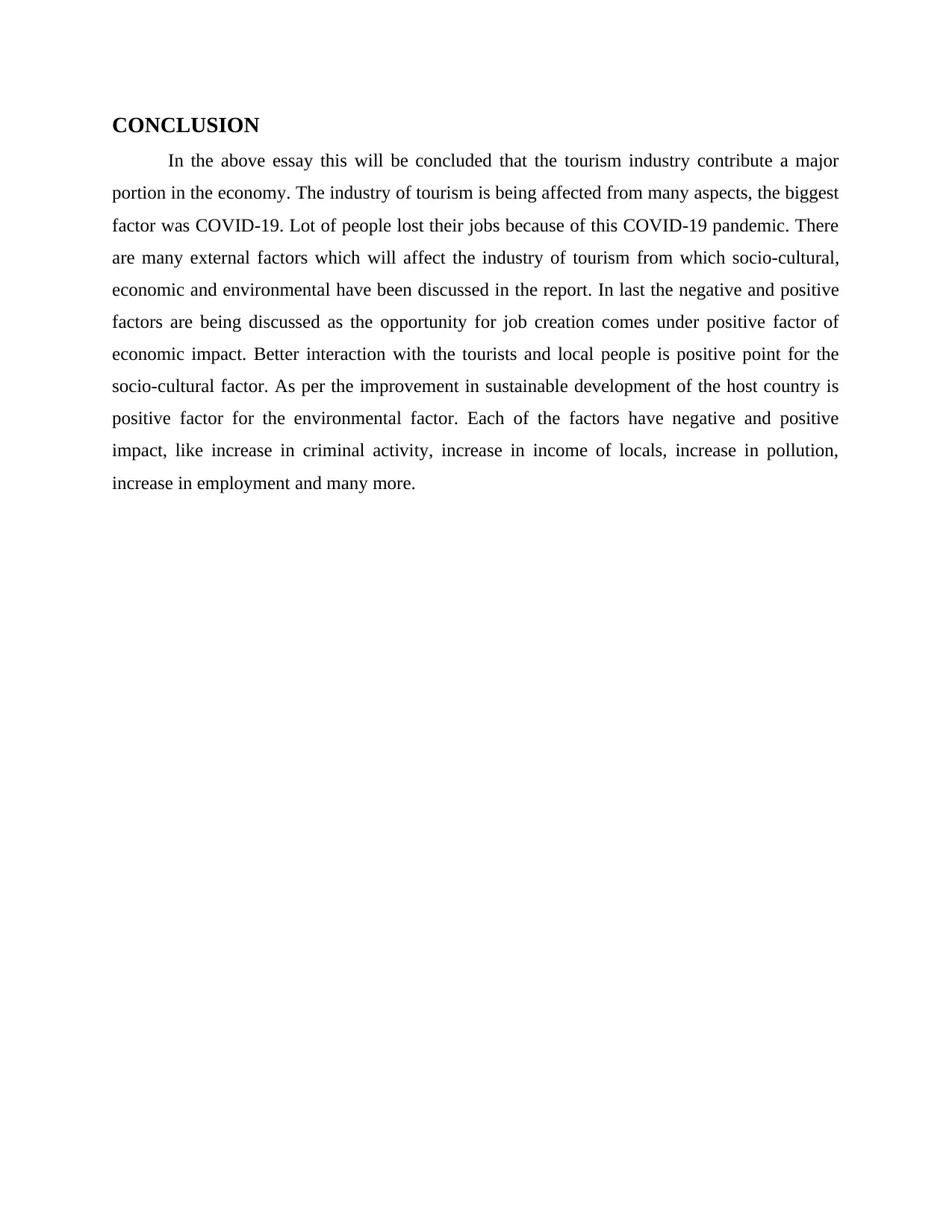
CONCLUSION
In the above essay this will be concluded that the tourism industry contribute a major
portion in the economy. The industry of tourism is being affected from many aspects, the biggest
factor was COVID-19. Lot of people lost their jobs because of this COVID-19 pandemic. There
are many external factors which will affect the industry of tourism from which socio-cultural,
economic and environmental have been discussed in the report. In last the negative and positive
factors are being discussed as the opportunity for job creation comes under positive factor of
economic impact. Better interaction with the tourists and local people is positive point for the
socio-cultural factor. As per the improvement in sustainable development of the host country is
positive factor for the environmental factor. Each of the factors have negative and positive
impact, like increase in criminal activity, increase in income of locals, increase in pollution,
increase in employment and many more.
In the above essay this will be concluded that the tourism industry contribute a major
portion in the economy. The industry of tourism is being affected from many aspects, the biggest
factor was COVID-19. Lot of people lost their jobs because of this COVID-19 pandemic. There
are many external factors which will affect the industry of tourism from which socio-cultural,
economic and environmental have been discussed in the report. In last the negative and positive
factors are being discussed as the opportunity for job creation comes under positive factor of
economic impact. Better interaction with the tourists and local people is positive point for the
socio-cultural factor. As per the improvement in sustainable development of the host country is
positive factor for the environmental factor. Each of the factors have negative and positive
impact, like increase in criminal activity, increase in income of locals, increase in pollution,
increase in employment and many more.
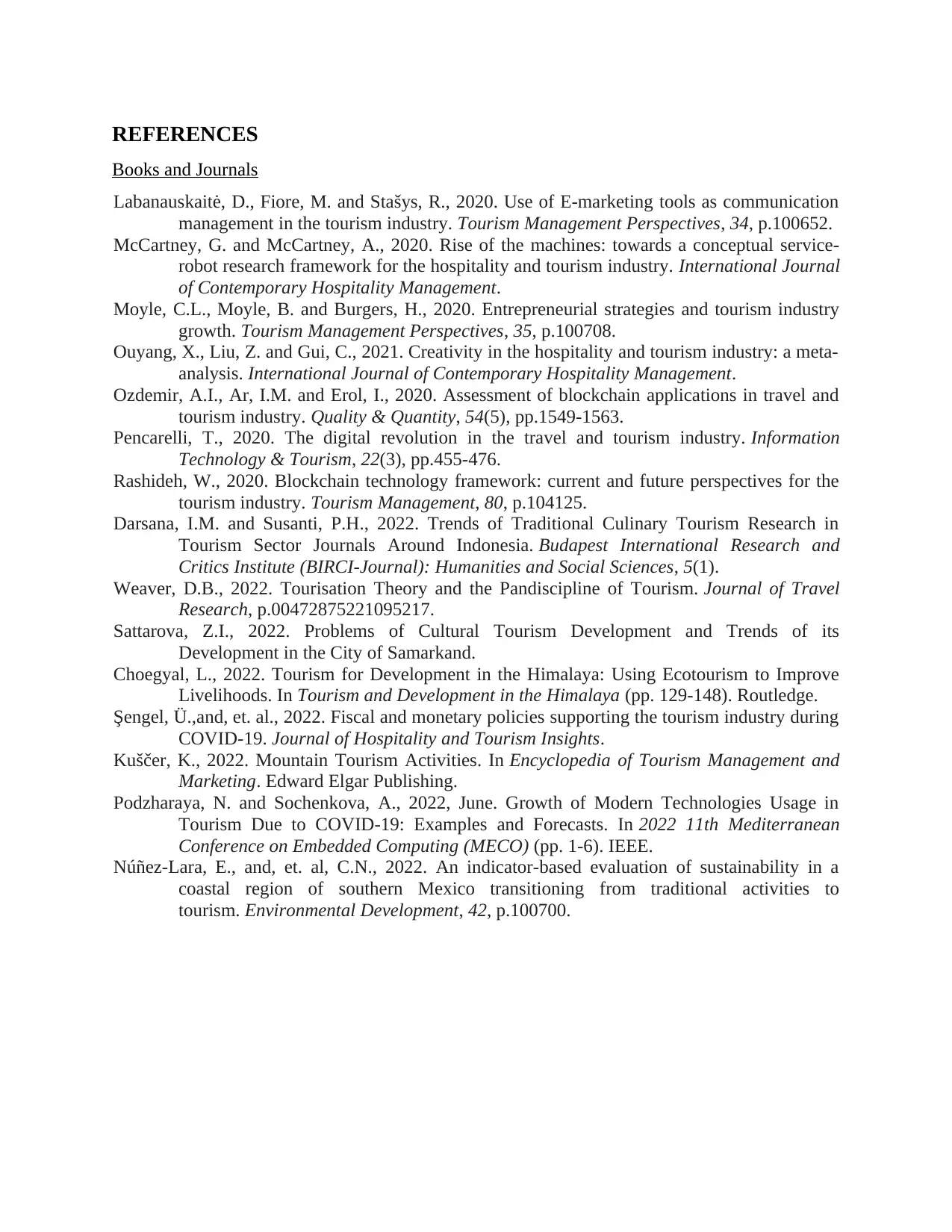
REFERENCES
Books and Journals
Labanauskaitė, D., Fiore, M. and Stašys, R., 2020. Use of E-marketing tools as communication
management in the tourism industry. Tourism Management Perspectives, 34, p.100652.
McCartney, G. and McCartney, A., 2020. Rise of the machines: towards a conceptual service-
robot research framework for the hospitality and tourism industry. International Journal
of Contemporary Hospitality Management.
Moyle, C.L., Moyle, B. and Burgers, H., 2020. Entrepreneurial strategies and tourism industry
growth. Tourism Management Perspectives, 35, p.100708.
Ouyang, X., Liu, Z. and Gui, C., 2021. Creativity in the hospitality and tourism industry: a meta-
analysis. International Journal of Contemporary Hospitality Management.
Ozdemir, A.I., Ar, I.M. and Erol, I., 2020. Assessment of blockchain applications in travel and
tourism industry. Quality & Quantity, 54(5), pp.1549-1563.
Pencarelli, T., 2020. The digital revolution in the travel and tourism industry. Information
Technology & Tourism, 22(3), pp.455-476.
Rashideh, W., 2020. Blockchain technology framework: current and future perspectives for the
tourism industry. Tourism Management, 80, p.104125.
Darsana, I.M. and Susanti, P.H., 2022. Trends of Traditional Culinary Tourism Research in
Tourism Sector Journals Around Indonesia. Budapest International Research and
Critics Institute (BIRCI-Journal): Humanities and Social Sciences, 5(1).
Weaver, D.B., 2022. Tourisation Theory and the Pandiscipline of Tourism. Journal of Travel
Research, p.00472875221095217.
Sattarova, Z.I., 2022. Problems of Cultural Tourism Development and Trends of its
Development in the City of Samarkand.
Choegyal, L., 2022. Tourism for Development in the Himalaya: Using Ecotourism to Improve
Livelihoods. In Tourism and Development in the Himalaya (pp. 129-148). Routledge.
Şengel, Ü.,and, et. al., 2022. Fiscal and monetary policies supporting the tourism industry during
COVID-19. Journal of Hospitality and Tourism Insights.
Kuščer, K., 2022. Mountain Tourism Activities. In Encyclopedia of Tourism Management and
Marketing. Edward Elgar Publishing.
Podzharaya, N. and Sochenkova, A., 2022, June. Growth of Modern Technologies Usage in
Tourism Due to COVID-19: Examples and Forecasts. In 2022 11th Mediterranean
Conference on Embedded Computing (MECO) (pp. 1-6). IEEE.
Núñez-Lara, E., and, et. al, C.N., 2022. An indicator-based evaluation of sustainability in a
coastal region of southern Mexico transitioning from traditional activities to
tourism. Environmental Development, 42, p.100700.
Books and Journals
Labanauskaitė, D., Fiore, M. and Stašys, R., 2020. Use of E-marketing tools as communication
management in the tourism industry. Tourism Management Perspectives, 34, p.100652.
McCartney, G. and McCartney, A., 2020. Rise of the machines: towards a conceptual service-
robot research framework for the hospitality and tourism industry. International Journal
of Contemporary Hospitality Management.
Moyle, C.L., Moyle, B. and Burgers, H., 2020. Entrepreneurial strategies and tourism industry
growth. Tourism Management Perspectives, 35, p.100708.
Ouyang, X., Liu, Z. and Gui, C., 2021. Creativity in the hospitality and tourism industry: a meta-
analysis. International Journal of Contemporary Hospitality Management.
Ozdemir, A.I., Ar, I.M. and Erol, I., 2020. Assessment of blockchain applications in travel and
tourism industry. Quality & Quantity, 54(5), pp.1549-1563.
Pencarelli, T., 2020. The digital revolution in the travel and tourism industry. Information
Technology & Tourism, 22(3), pp.455-476.
Rashideh, W., 2020. Blockchain technology framework: current and future perspectives for the
tourism industry. Tourism Management, 80, p.104125.
Darsana, I.M. and Susanti, P.H., 2022. Trends of Traditional Culinary Tourism Research in
Tourism Sector Journals Around Indonesia. Budapest International Research and
Critics Institute (BIRCI-Journal): Humanities and Social Sciences, 5(1).
Weaver, D.B., 2022. Tourisation Theory and the Pandiscipline of Tourism. Journal of Travel
Research, p.00472875221095217.
Sattarova, Z.I., 2022. Problems of Cultural Tourism Development and Trends of its
Development in the City of Samarkand.
Choegyal, L., 2022. Tourism for Development in the Himalaya: Using Ecotourism to Improve
Livelihoods. In Tourism and Development in the Himalaya (pp. 129-148). Routledge.
Şengel, Ü.,and, et. al., 2022. Fiscal and monetary policies supporting the tourism industry during
COVID-19. Journal of Hospitality and Tourism Insights.
Kuščer, K., 2022. Mountain Tourism Activities. In Encyclopedia of Tourism Management and
Marketing. Edward Elgar Publishing.
Podzharaya, N. and Sochenkova, A., 2022, June. Growth of Modern Technologies Usage in
Tourism Due to COVID-19: Examples and Forecasts. In 2022 11th Mediterranean
Conference on Embedded Computing (MECO) (pp. 1-6). IEEE.
Núñez-Lara, E., and, et. al, C.N., 2022. An indicator-based evaluation of sustainability in a
coastal region of southern Mexico transitioning from traditional activities to
tourism. Environmental Development, 42, p.100700.
1 out of 7
Related Documents
Your All-in-One AI-Powered Toolkit for Academic Success.
+13062052269
info@desklib.com
Available 24*7 on WhatsApp / Email
![[object Object]](/_next/static/media/star-bottom.7253800d.svg)
Unlock your academic potential
© 2024 | Zucol Services PVT LTD | All rights reserved.


